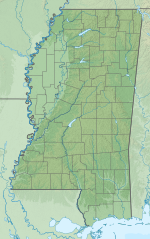Hattiesburg Bobby L. Chain Municipal Airport
Hattiesburg Bobby L. Chain Municipal Airport (former Hattiesburg Army Air Field) | |||||||||||
|---|---|---|---|---|---|---|---|---|---|---|---|
AMSL 151 ft / 46 m | | ||||||||||
| Coordinates | 31°15′54″N 89°15′10″W / 31.26500°N 89.25278°W | ||||||||||
| Map | |||||||||||
| Runways | |||||||||||
| |||||||||||
| Statistics (2012) | |||||||||||
| |||||||||||
Hattiesburg Bobby L. Chain Municipal Airport (IATA: HBG[2], ICAO: KHBG, FAA LID: HBG) in Forrest County, Mississippi is owned by the City of Hattiesburg and is five miles southeast of downtown.[1]
The National Plan of Integrated Airport Systems for 2011–2015 called it a general aviation facility.[3] There is no scheduled airline service; Hattiesburg–Laurel Regional Airport has commercial airline service.
History
The airport opened in 1930.
Alarmed by the
Construction involved runways and airplane hangars, with three concrete runways, several taxiways and a large parking apron and a control tower. Several large hangars were also constructed. Buildings were ultimately utilitarian and quickly assembled. Most base buildings, not meant for long-term use, were constructed of temporary or semi-permanent materials. Although some hangars had steel frames and the occasional brick or tile brick building could be seen, most support buildings sat on concrete foundations but were of frame construction clad in little more than plywood and tarpaper. On 8 December 1941, Hattiesburg Army Air Field opened, assigned to the Third Air Force.
The first mission was antisubmarine patrols along the
The
The
In early 1945 military activities were phased down, and the Air Force put Hattiesburg on standby inactive status. Return to full civil control was in April 1946. [4] [5]
The first airline flights were Delta DC-3s in 1948; Southern appeared for a year or two around 1951. Delta left and Southern returned in 1960, and Southern moved to the new
Facilities
The airport covers 420 acres (170 ha) at an elevation of 151 feet (46 m). Its one runway, 13/31, is 6,094 by 150 feet (1,857 x 46 m) asphalt.[1]
In the year ending June 14, 2012 the airport had 39,672 aircraft operations, average 108 per day: 88% general aviation, 8% military, 3% airline, and 1% air taxi. 45 aircraft were then based at the airport: 78% single-engine, 16% multi-engine, and 7% helicopter.[1]
See also
References
- ^ PDF. Federal Aviation Administration. Effective November 15, 2012.
- ^ "IATA Airport Code Search (HBG – City: Hattiesburg, Airport: Bobby L. Chain Mun.)". International Air Transport Association. Retrieved August 13, 2013.
- ^ "Appendix A: List of NPIAS Airports with 5-Year Forecast Activity and Development Cost". National Plan of Integrated Airport Systems (NPIAS) Reports. Federal Aviation Administration. October 4, 2010. Archived from the original on 2012-10-27.
- ^
 This article incorporates public domain material from the Air Force Historical Research Agency
This article incorporates public domain material from the Air Force Historical Research Agency
External links
- Southeast Aviation, the fixed-base operator (FBO)
- Aerial image as of January 1996 from USGS The National Map
- FAA Terminal Procedures for HBG, effective June 13, 2024
- Resources for this airport:
- FAA airport information for HBG
- AirNav airport information for KHBG
- ASN accident history for HBG
- FlightAware airport information and live flight tracker
- NOAA/NWS weather observations: current, past three days
- SkyVector aeronautical chart, Terminal Procedures



